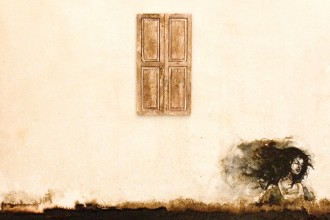Bahrnegash Bellete on the challenges (and rewards) of translating from Amharic to English
Before I venture to describe what proved to be an enthralling, challenging, and, in the end, a thoroughly satisfying adventure, I have to confess that I am a veritable novice at what I have attempted to do here — translating Amharic poems into English. I decided to tread treacherous ground that few of my fellow native Amharic speakers have dared to tread with an audacity that often seemed to me to border on foolhardiness.
I know there are many that with good reason argue poems are untranslatable. I also know that even those who do not go that far would admit to a host of peculiar difficulties associated with translating poems. At the same time, however, I could only despair at the thought of a literary experience limited to the confines of the creative and expressive reach of one’s own language. I imagined how impoverished my own experience would have been had I not had the benefit of reading translated works. How else could I, or anyone else for that matter, have come to commune with great poets and literary figures such as Virgil, Dante, Rabelais, Khayyam, Pushkin, Akhmatova, Cervantes, Fuentes, Borges, and Basho, to name only a few, scattered across wide expanses of time and space?
Going into the translation work itself, the most fascinating discovery for me was the extraordinary degree of intimacy the work compels the translator to develop with each of the poems being translated. In my early college days I had come across a book called ‘How Does a Poem Mean?’, by John Ciardi, that I used in the study of poetry. In it, Ciardi shows how a poem conveys the meaning it intends to impart in many ways, often at the same time — ranging from its physical and metric structure to its musicality, its adroit manipulation of a lexicon to its use of apt metaphors, its use of vivid imagery to its economy, and many more. The intimacy I spoke of above must come from the translator’s reading and re-reading of each poem in an attempt to discover the many ways by which the poem means with the intention whenever possible of porting them whole to the translation. The difference between such reading and a more leisurely one, albeit as attentive, may be that the latter relegates the poem’s ways to operate at the subliminal level whereas the former makes them explicit to the translator.
Earlier, I alluded to a longstanding debate about the translatability of poems and the challenges associated with translating them if and when one decides to do so. I would like to start with what I found in Amharic poetry to be virtually untranslatable.
There is a highly regarded genre in Amharic poetry referred to by many as qəne (though the term is also used as a generic term for poetry) that exploits the double meaning of many Amahric words and metaphors to convey two entirely different meanings in the same set of verses. Almost always, there is an obvious, readily accessible meaning, and a concealed one that the reader or listener has to work at to uncover. The two meanings are referred to as wax and gold (sämə əna worək) where the obvious one is the wax and the hidden one the gold. Qəne is used in various ways under various circumstances ranging from surreptitiously criticising someone while appearing to make a humorous quip to secretly expressing one’s love to another while seeming to, say, deprecating them. I have come to believe that much of qəne poetry is virtually untranslatable, at least in a way that does not compromise its integrity.
To illustrate, I will use two examples from the best known qəne poet of recent memory, Negadras Tessema Eshete (Negadras is an Ethiopian title). Using a transliteration convention adopted by Thomas Kane in his laudable Amharic-English Dictionary (1990), I will first present each poem as written in Amharic and provide the two meanings conveyed separately. To put both pieces in context, there was a contest for the throne in the Ethiopian court at the dawn of the twentieth century. There was a palace coup carried out by Princess Zewditu, Menelik’s (the dead emperor whose succession was the subject of contest) daughter, Ras Tafari Makonnen, who was eventually crowned Emperor Haile Selassie, and Fitawrari Habte Giorgis Dinegde, the then minister of defense, to oust Lij Iyassu, the legitimate heir. There were many who sided with Iyassu who ended up in prison and were forgotten there for some time as the conspirators themselves ended up in disarray. In the examples below, Tessema Eshete, who was sympathetic to the prisoners, is making sarcastic and critical statements about the affair while seeming to indulge in benign, humorous musing.
First,
“dÉ™ngät säläsÉ™bäw bälÉ™Äe ţäţəÄe
lÉ™motÉ™läÄÉ™hu näw täfÉ™Äe täfÉ™Äeâ€
The ‘wax’ of this couplet can be translated as:
“Having engorged myself in idle indulgence
I’m on the verge of death throwing up, throwing up.â€
The ‘gold’ relies on the double entendre embedded in the word täfÉ™Äe, which means both ‘throwing up’ and ‘in (or from) FÉ™Äe’ which was one of the towns where the prisoners were held.
Thus, the second translation of the poem, can be rendered as:
“Having engorged myself in idle indulgence
I’m on the verge of death in FÉ™Äe, in FÉ™Äe.â€
In effect, the prisoner, who must have been close to the court, is regretting the fact that he was caught unawares by the ongoing intrigue.
As a second example,
“yÉ™hÉ™Ä yäňä É™mäbet mÉ™näw dähäyÉ™Äi
É™räs täfäri zänd mär bÉ™lä läkÉ™Äiâ€
Here, the translation of the obvious, the ‘wax,’ may be rendered as:
“Oh how has our lady become so needy
as to send for some honey to Ras Tafariâ€
Whereas the hidden meaning, the ‘gold,’ is revealed if the poem is translated as:
“Oh how has our lady become so lowly
as to plead with Ras Tafari to show mercyâ€
The operative word here is mär, which translates into both the noun ‘honey’ and the verb ‘show mercy’ (or forgive).
As demonstrated above, the distinctive feature of qəne is delivering two entirely different meanings in the same set of verses. I am convinced that it is practically impossible to translate a set of qəne verses into an equivalent set of verses in English (or another language) that would convey the two original meanings at once.
Even when translating poems that seem to be amenable to such treatment, however, there are challenges that arise from the peculiarities of the source and target languages as they relate to each other.
Then there is the difference between the grammars of the two languages. Of particular note, in my experience, was that the word orders in the differing syntaxes used by Amharic and English were different. As explained in ‘The Cambridge Encyclopaedia of Language’ (David Crystal, 1987), the English language, like 75% of world languages, has a syntactical structure that generally follows an SVO (Subject, Verb, Object) word order, whereas Amharic follows an SOV word order. The difficulties that occasionally arose from this difference, however, were adequately assuaged by the flexibility of English with regard to the rules of syntax.
The fact that the English language has a much larger vocabulary than Amharic, I felt, allowed for creative alternatives in situations where I ran into Amharic terms and phrases that did not have direct equivalents in English. This made the difference between the two lexicons much less troublesome than I expected.
The most intriguing and demanding challenges stemmed from two other distinctions between the two languages, the difference between their respective morphologies and alphabets. The Amharic language uses a syllabic alphabet it inherited from its predecessor gə´əz where each letter stands for a consonant with a vowel inhering therein. This makes for a physical compression of words and phrases that cannot be achieved if the same words or phrases were phonetically rendered in the Latin alphabet. For example, አማáˆáŠ› (ämärəňä, meaning Amharic) which contain four syllabic letters, ä mä rÉ™ ňä, would look something like amarinya or amarigna in a loose Latin treatment, ending up with no fewer than eight letters.
A similar compression results from the peculiar morphology of the Amharic language. In Amharic, it is not uncommon for two or three words to be condensed into one word. The combination of the two types of compressions that characterize Amharic, on many occasions, make the English translation of a verse excessively long compared to the original. Compare the opening verses of ‘Fire or Bloom’ in Amharic and in English (twenty-four words translate into forty-one).
እናᤠእንደኔና እንዳንቺá‹á¤ የá‹á‰ ት á‹“á‹áŠ‘ን የታወረ
እáŒáˆ¨ ሕሊናዠየከረረá¤
በሕረ-ሃሳቡን á‹«áˆá‰³á‹°áˆˆ
የá‹á‰ ት á‹“á‹áŠ‘ የሰለለ
ሰማዠጨለማ áŠá‹ እንጂᤠአበባ እኮ አá‹á‹°áˆˆáˆ አለá¢
á‹«áˆá‰³á‹°áˆˆá¢
And thus, like you and I, he whose eye for beauty has gone blind
whose legs of conscience have gone stiff
not blessed with imagination
whose eye for beauty has gone dim
avers the sky is darkness, not bloom.
The wretched one.
Antonella Francini, apparently addressing a similar problem, wrote in Callaloo (‘Notes on Translating Yusef Komunyakaa’s Poetry Into Italian,’ Summer 2005) “The metrical structure of a translated line always appears encumbered by words that are too long… not to mention the additional prepositions and articles you find once you turn English possessives and genitives into their two-word Italian equivalents. Or when you are obliged to unite those long nominal chains, thus dissolving and diluting compression and visual effects.†Even though I do not know Italian, I would dare say that the problem is more severe in translating from Amharic to English, since the grammatical compression is compounded by the morphological one described above. When a translator tries to compensate for such differences between the source and target languages, the trade-off is between semantic fidelity and aesthetic (metrical and visual) fidelity to the original. I opted to lean towards semantic fidelity whenever the compromise seemed to cause too much distortion one way or the other.
Bahrnegash Bellete was born in Asmara, Eritrea, then an Ethiopian province, and grew up in four different parts of the country. He attended Haile Selassie I University in Addis Ababa for one semester and in 1972 left for the United States to continue his education. What was initially intended to be a brief sojourn in pursuit of higher education turned out to be an extended, thirty-three-year stay abroad. He now lives in Ethiopia where he owns and operates a communications company and has been serving as the information and communication technology (ICT) development officer of Addis Ababa University.
(This is an edited and abridged version of an article that first appeared in Callaloo (Callaloo 33:1 (2010), 58-63. © 2010 The Johns Hopkins University Press). It is republished here with kind permission from the author and Johns Hopkins University Press.)





